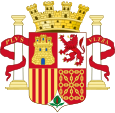People's Republican Army
The Spanish Republican Army, Spanish: Ejército de la República Española, was the main branch of the Armed Forces of the Second Spanish Republic between 1931 and 1939.
It became known as People's Republican Army (Ejército Popular de la República) after it was reorganized, following the disbandment of the voluntary militias that were formed in July 1936 at the beginning of the Spanish Civil War.
The Spanish Republican Army went through two clear phases during its existence:
The losing of the last colonies, Cuba and Philippines in 1898 made the popularity of the armed forces wane in Spain. Military leaders resented the attitude of the Spanish politicians and the public opinion who unjustly blamed the Spanish Military for the failures in the colonies. In November 1905 Spanish Army personnel stormed the offices of Catalan magazine Cu-Cut!, where also En Patufet and La Veu de Catalunya were located, for having published a caricature ridiculing the military.
Following the attacks, the Captain generals of Sevilla, Barcelona and Madrid openly opposed the prosecution of those members of the military involved in the storming. This crisis led in 1906 to the approval of the Ley de Jurisdicciones ("Law of Jurisdictions"), which severely restricted freedom of expression in Spain by making speech against "Spain and its symbols"—the Spanish Armed Forces including themselves as one of the symbols— a criminal offence. According to renowned writer Salvador de Madariaga the Spanish Armed Forces became henceforward a "State within the State" that would interfere in civilian matters in an overbearing manner, becoming a major player in Spanish politics. Other Spanish intellectuals such as Miguel de Unamuno and Ramiro de Maeztu were seriously worried at the time about the future implications of the "Law of Jurisdictions". Unamuno openly expressed his concern that it would be left to the military to define what was correct regarding patriotism.
...
Wikipedia



